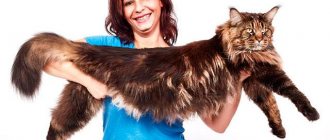The cat family is cunning animals that, even with love and respect for their own owners, put themselves and comfort first. These cats include the domestic puma, another name for Messi. The animals are playful, affectionate, but with well-developed hunting instincts. The puma behaves like any domestic cat, differing only in its particularly large size.
The key features and behavior of domestic pumas are clearly illustrated by the example of a pet named Messi.
Classification
- Kingdom: Animalia (animals)
- Phylum: Chordata
- Class: Mammalia (mammals)
- Order: Carnivora (predatory)
- Family: Felidae (felines)
- Genus: Puma (cougars)
- Species: Puma concolor (puma)
Puma concolor is the only species of the genus Puma. Until 1995, pumas belonged to the genus Felis, which formerly included many much smaller and less vocal cats, but not jaguars (Panthera onca).
Description
The name puma comes from the Quechua Indian language and means “powerful.” This word was borrowed first by the Spaniards in the 16th century, then by the British in the 18th century. An alternative name, cougar, comes from the Portuguese çuçuarana,
The Portuguese, in turn, borrowed the name from the indigenous inhabitants of southern Brazil. Early Spanish conquistadors nicknamed the predator the mountain cat, or simply the lion. In Canada and the western United States, the cougar was also called the mountain lion; the name first appeared in print in 1858.
The puma is listed in the Guinness Book of Records as the animal with the most names. In the English language alone there are more than 40 different names for this animal.
The animal's scientific name Puma Concolor (originally Felis Concolor) was proposed by Carl Linnaeus in 1771, who described the predator as a long-tailed wild cat from Brazil. From Latin, concolor is translated as one-color, which reflects the uniform color and complete absence of spots on the puma’s skin. The animal was assigned to the genus Puma by Scottish naturalist William Jardine in 1834. The puma's closest relatives are jaguarundi and cheetahs.
Appearance
Pumas have short and dense fur. The specific name concolor ("solid") refers to the animal's fur, but the color tone is very varied. The most common types of mountain lions are tan, reddish brown, and silver gray; the chin and chest, as well as the entire lower part of the body, are always white. The hue varies geographically and seasonally, and sightings of black pumas have also been reported. The tip of the tail of these cats is always dark. Newborn pumas are beige and heavily spotted; the markings disappear during the first year of life.
Photo: Jeff Wendorff
Pumas have five toes on their front feet and four on their back feet. They can retract their claws. Their long tail is usually held close to the ground when walking.
Colors
The following colors of Abyssinian cats are accepted by the standards: sorel, fawn, wild, blue. There are also several unrecognized varieties in brown, chocolate, silver, and lilac.
- The Abyssinian fawn cat wears a light brown (beige) coat with cocoa-colored markings.
- The blue Abyssinian is characterized by having a warm gray, blue-gray or beige coat throughout the body, with darker markings on the face and tail.
- The sorrel color is the color of the red cat. It is covered with reddish-red fur, and chocolate markings are clearly visible on its face and tail.
- The wild color of the Abyssinian is the most common. The coat is black, dark brown or ocher. A black tail and muzzle complement the appearance of cats with wild colors.
A color in which there are white areas on the chin is not valued; the fewer there are, the higher the place the beauty occupies at the exhibition.
Allergy to Abyssinians
It is possible to develop an allergy to the Abyssinian breed, but this is unlikely. If a cat is said to have a hypoallergenic coat, it means that they produce fewer allergens than others. Abyssinians are one of the breeds called by owners and breeders as anti-allergenic.
Size
Although taxonomically the puma belongs not to large, but to small and medium-sized cats, it is nevertheless the fourth largest cat in the world (after the tiger, lion and jaguar). Cougars found around the equator are among the smallest species, while those found in the far north and southern regions of their range are considered the largest subspecies.
Photo: Evgeny555
The height of this wild cat at the shoulders is approximately 60-90 cm; the length of the head and body in males ranges from 105 to 195 cm, in females - from 95 to 151 cm. The tail has a length from 60 to 97 cm. The weight of males varies, depending on the habitat, from 53 kg to 72 kg, more in northern areas of distribution it is about 100 kg. Females usually weigh between 34 and 48 kg. The largest male recorded by scientists had a record weight of more than 125 kg.
- Length with tail: from 150 to 275 cm
- Average length of males: 245 cm
- Average length of females: 205 cm
- Shoulder height: from 60 to 90 cm
- Average weight of males: 68 kg
- Average weight of females: 55 kg
Keeping animals at the Moscow Zoo
During the existence of the zoo, pumas were kept here several times. These cats live well in captivity and bear offspring. Currently, a young large male puma lives in “Cat Row”, who arrived from the Veliky Ustyug Zoo. He walks around the enclosure not only in the evening, like most cats, but is often active during the day. His daily diet includes 1.5 kg of beef, a little ox heart and 4-5 rats, which he eats with great appetite. The beast greets familiar people with a uterine sound that vaguely resembles a purr. We hope that our handsome guy will soon have a girlfriend, and they will make us happy with the birth of little spotted kittens.
Geographic range and habitat
The puma boasts the widest distribution range of any member of the New World class of mammals. Only lynx and forest cats can compete with it. During the European settlement of the New World, the puma occupied the entire territory of what is now the 48 southern states of the United States and southern Canada. Currently, mountain lions are primarily found west of 100 degrees west longitude (roughly central Texas to Saskatchewan, excluding southern Texas), as far south as Chile.
Cougars prefer a variety of habitats, including grasslands, chaparral, woodlands, and swamps. This animal is just as at home in the Rocky Mountains as it is in the Argentine pampas or the dense Amazon rainforest. However, mountain lions avoid agricultural lands, plains, and similar habitats lacking topographical or vegetative cover.
Character
The character of Abyssinian cats is balanced, delicate, and flexible. The animal has extraordinary intelligence, understands what is wanted from it, and generally does not cause problems for the owner. Easy to train and toilet trained.
Interestingly, cats love to perform tricks so much that they even received the nickname clowns. The Abyssinian needs to be educated, accustomed to the routine in the house.
This representative of the cat family is extremely active and inquisitive. Abyssinians happily explore every corner of the house, not forgetting to keep an eye on their household members from high objects. Any available items or specially purchased mice or balls can be used as toys for your pet.
Abyssinian cats require a lot of communication, attention and affection. They follow their beloved owner with their tail and will keep him company in any business. The Abyssinian's voice is thin, very pleasant, and will not irritate. Cats are not annoying in character; they have an innate sense of tact.
The character and behavior of a kitten differs from the habits of an adult animal. The kitten is clumsy, funny, and not endowed with that royalty inherent in grown-up Abyssinians. Adult cats love respect, demand that their opinions be taken into account, and feel like equal members of the family.
Abyssinian cats live peacefully with children, find a common language, and share a love of games. Abyssinian beauties do not tolerate loneliness well, so it is better if there are other animals at home. You can safely leave such a kitty with the children, even if you pull the Abyssinian’s tail, she will simply leave without showing aggression.
Behaves warily and fearfully around strangers. Can get along with friendly dogs, tolerates other felines, but strives to dominate. In the family he chooses one person as the owner, becoming his most devoted friend.
Home range
Cougars live in low-density areas (one to five individuals per 100 square kilometers), so they require large areas with ample prey and reliable ambush cover to survive. In most habitat regions, there are about two or three mature females for every male. There is a lot of overlap between the home ranges of females, but very little overlap between the territories of neighboring males. Home ranges vary greatly in size, but females typically have average territories of 140 square kilometers, while males' territories are almost twice that size.
What does it eat?
The main prey of pumas are deer, mountain sheep, bulls, and elk. The predator often attacks animals that are larger than itself, and it will definitely hide the uneaten remains of the carcass in a secluded place and return to them later. Knowing this feature of mountain lions, other predatory animals often act as parasites, searching for and eating hidden meat.
In the absence of large prey, cougars attack Canadian beavers, raccoons, monkeys, squirrels and small rodents, and can hunt birds, snakes, fish and insects.
Cougars do not distinguish between wild and domestic animals and, on occasion, can feast on not only the meat of ungulates, but even dogs or cats. There are known facts when hungry predators ate their relatives who died in a duel.
On average, one adult animal requires up to 1 ton of meat per year.
TIGER
Subspecies
Seven subspecies of Puma concolor are recognized by most classifications. In total, up to 32 subspecies of puma have been described. However, according to molecular genetics, there are only 7 phylogeographic groups. All North American cougars are virtually indistinguishable genetically from each other and represent a largely homogeneous population. Populations in Central and South America show greater diversity.
This is explained by the fact that the ancestors of North American pumas immigrated from South America only about 10,000 years ago at the end of the last Ice Age. Since several large animal species went extinct in the Americas at the same time, it is assumed that the cougar suffered the same fate in North America. However, she managed to survive in South America and then move north again.
Subspecies:
- P.c. couguar - the North American continent from southern Canada to Guatemala;
- P.c. coryi – southern Florida;
- P.c. costaricensis – Central American countries;
- P.c. capricornensis – eastern part of the South American continent;
- P.c. concolor – northern part of Latin America;
- P.c. cabrerae - the central part of the South American continent;
- P.c. puma - Chile and southwestern Argentina.
Photo: Wikipedia
The Florida cougar is the rarest subspecies of cougar. About 88% of these pumas have the unusual feature of a curled tail. Although it looks a little funny, the reasons for this mutation are due to very low genetic diversity, mainly caused by human activities.
Natural enemies
The puma has no natural enemies; no one hunts it in nature. However, the animal faces stiff competition for prey from other predators. Grizzly bears, black bears, wolves and jaguars take at least 10% of the puma's prey, in some regions up to 40%. In northern latitudes, packs of wolves pose a great threat to pumas - a cougar is easily able to defeat one wolf, but is powerless against an entire pack. Therefore, cougars avoid wolf packs and try to raise kittens away from wolf habitats.
Grizzly bears are the dominant predators in their habitat. Not only cougars, but also other local predators - wolves and black bears - are forced to give them their prey. In South America, the dominant predator is the jaguar, whose territory often coincides with the cougar's hunting range. Therefore, South American pumas are often forced to hunt smaller prey than jaguars to avoid competition with the larger predator.
Large reptiles also pose a threat to cougars. Unlike jaguars, pumas are not as well adapted for hunting reptiles, so these predators stay away from bodies of water with large reptiles. Cases have been recorded of cougars being attacked by large alligators and pythons.
Behavior
Cougars are extremely agile and energetic. These are strong athletes, climbing trees and jumping long distances of up to 12 meters with equal ease in pursuit of their prey. Their maximum running speed is 65-80 km/h.
Cougars are diurnal solitary hunters who unite in pairs only during the breeding season, but such breeding associations exist only for 1-6 days. Cougars are usually silent animals, but during the mating season they emit frightening, drawn-out screams with short breaks of several hours. Unlike other felines, such as the lion or tiger, the puma does not growl , but purrs, like a regular domestic cat. This feature is the reason for the exclusion of the puma from the genus Panthera.
Mountain Lion Choice
The price includes several components:
- Age. An adult animal that has been trained in training is valued at a higher price. A newborn kitten will cost less than a month old.
- Floor. They ask more for a female.
- View. There are 6 subspecies of the animal. For a rarer subspecies, the price is correspondingly higher.
It is worth calculating the cost of intercity delivery, if any. Some customers have a similar service. In Russia, not all subspecies of pumas are bred. Black cougars are considered more expensive, of which there are few even in the wild.
The price starts from 100-130 thousand rubles. per month's individual. The older the cougar, the higher the cost.
You can legally purchase a puma only in a nursery. There are known cases of purchasing a cougar from a petting zoo, but the best solution remains a nursery. Only in this case can you be sure that the puma kitten is healthy and has the necessary veterinary documents. In addition, the buyer will be advised by the breeder regarding maintenance, nutrition and some nuances.
Diet
The puma's prey list is long - the cat is considered a very effective predator. In most areas, the main item on a mountain lion's menu is ungulate mammals (usually deer), but sometimes the diet expands to include:
- porcupines;
- hares;
- beavers;
- coyotes;
- raccoons;
- lynxes;
- skunks;
- possums;
- young bears.
Cougars also attack domestic animals, including sheep, goats, young calves, dogs and horses. Since the cougar causes great damage to sheep and cattle farms, it has been completely exterminated in some areas.
Photo: Neil McIntosh
Mountain lions are active primarily during dusk, nighttime, and dawn. North American individuals annually kill fifty ungulates and countless small animals. Cougars rarely feed on carcasses they have not killed. When catching prey, this wild cat moves within a radius of approximately 10 km, hunting in several trips, averaging 1.5 hours each. Movement through the territory alternates with shorter periods of pursuit, waiting in ambush, or resting.
The cougar leaps from cover at close range, mostly from behind its chosen victim. When a large mammal is captured, the predator drags the carcass to a hiding place, covering it with leaves and other plant material to protect the food from scavengers. During the day, the cougar usually rests within a radius of 50 meters from the carcass, reliably guarding it. On average, a mountain lion will feed on large prey for three days. With the exception of cases of catching large prey, the cougar rarely chooses the same place for rest for several days in a row.
Feeding
It is recommended to feed domestic pumas once a day, making sure to organize the only fasting day per week. At this time, you can only give fresh water, preferably filtered. The main diet of the animal is meat and meat by-products - it is possible to consume pork, chicken, turkey, chicken and beef liver, hearts, and ventricles. But beef is considered the most suitable option. Protein foods include raw eggs and fresh fish. In order to improve the digestive tract, vegetable oil, grain shoots, and bran are added to the diet. An adult’s menu must include “live food”—killed rabbits, feeding mice and rats, and small birds.
Your pet can eat beef several times a week.
It is necessary to feed according to the following scheme: 3 days a week - beef and other meat, 2 days. - livestock, 1 day - fish. You need to monitor the cleanliness of the water and change it regularly for fresh water. It is recommended to wash bowls and drinking bowls every day. To improve the health of big cats, you need to constantly give them a complex of vitamins and minerals. This is especially useful for growing kittens.
Veterinarians advise giving an adult domestic cougar 2 kilograms of meat and meat bones per day.
Breeding season and young development
Photo: www.evanmathieson.net
Mountain lions breed year-round, but at higher latitudes, birth rates peak during the summer months. The time interval between births is about two years, but this is shortened if the litter dies or disperses early.
Cubs are carried for an average of 90 days; the average litter size usually does not exceed three young, but a female can produce up to six kittens at a time. Spotted and blind cubs at birth weigh about 400 grams and have an average height of 30 cm. The “maternity hospital” is set up in almost impenetrable thickets of vegetation. The cubs are taken away from it when they are 1.5-2.5 months old.
Females feed and raise the young without the support of adult males, since they sometimes kill other people's kittens. Cubs do not leave their mother until 10-26 months, but the vast majority of them die before reaching this age. It is noteworthy that captured puma kittens are easy to tame.
Photo: Tierra Hotels
At the age of two, young females scatter in the range of 10-140 km (average 40 km); young males often run further, sometimes covering a distance of over 250 km. It can take them a year to become part of the breeding population, during which time an individual will successively occupy and leave one to five small temporary home territories. If a home range can be established, the cougar can be expected to live here for another 7-11 years.
- Breeding interval: every two years
- Breeding season: all year
- Average number of offspring: three cubs
- Gestation period: 82-96 days
- Average age of sexual or reproductive maturity: 2.5 years (females), 3 years (males)
The tragic story of the Berberov family
This happened in the 70s of the last century, when a lion, the king of beasts, appeared in the apartment of one family living in Baku. The Berberovs did not perform in the circus, and they did not have the skills of professional trainers, but the family loved animals, and very much so. Because of their love for them, they had many animals in their apartment. It was a real zoo in the apartment. One of their pets, already an adult lion, starred in the film “The Incredible Adventures of Italians in Russia.” This was a very kind lion, compared to the other lion, who turned out to be a real predator, sending his owner to a hospital bed and her 14-year-old son to the next world.
Puma - interesting facts
Lifespan and conservation status
In the wild, cougars can reach an age of 8 to 13 years. In captivity, their lifespan can exceed 20 years; A North American puma named Scratch lived to be almost 30 years old.
Bears and gray wolves sometimes hunt mountain lions, and sometimes they simply capture the carcasses of the prey they kill, leaving them without food. However, most cougar deaths occur from human hunters, other cougars, or road accidents.
Photo: www.paybanks.tk
The eastern puma, a subspecies of mountain lion that once inhabited the eastern United States and southern Ontario and was listed as endangered in 1973, has been officially declared extinct after 38 years. Florida's puma populations are now endangered.
In much of the western United States and Canada, mountain lion populations are considered stable or even increasing, except where habitat fragmentation occurs due to urbanization. There is no information available on Central and South American populations, although scientists believe there are no serious threats to them.
Where to buy a puma
There are many advertisements on the Internet about the sale of pumas by nurseries, individuals, and petting zoos. As a rule, all information with photographs of the animal is located on the personal websites of sellers.
Before purchasing, it is recommended to read reviews about the seller and visit specialized forums.
It is advisable that the animal be registered with the relevant authorities. This fact is confirmed by a veterinary passport, which indicates the date of birth and the fact that the animal was bred in captivity.
How to choose a kitten
Abyssinian kittens are ready for sale from the age of two months. But it’s better to wait, let them grow under the supervision of experienced breeders for up to 3-4 months in order to learn communication and behavior skills.
To choose the right purebred kitten, contact trusted nurseries, ask for documents and, of course, carefully examine the animal. There should be no bald spots on your future pet's coat, the skin is clean, without scratching, the eyes are clear, and the belly is not bloated. Ask if the kittens have been vaccinated.











